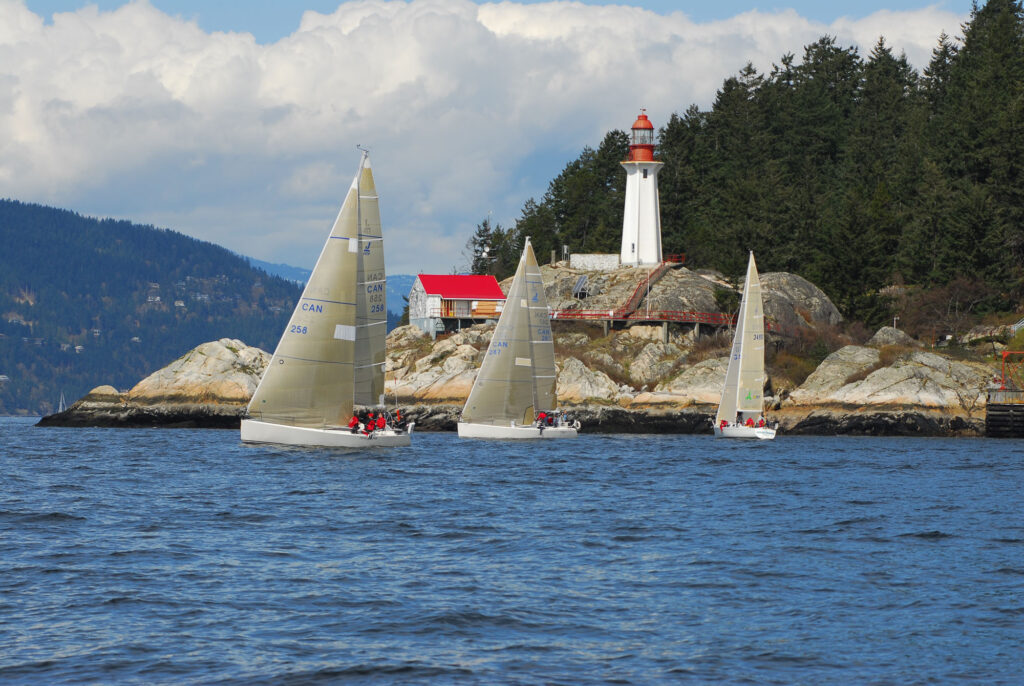
The Southern Straits Classic Yacht Race is a renowned sailing event that takes place annually in the waters off the southern coast of British Columbia, Canada. It is one of the premier offshore yacht races in the Pacific Northwest region. The race starts and finishes in West Vancouver, B.C., with the course taking racers through the intricate waterways of the Strait of Georgia, encompassing various islands, channels, and challenging tidal and weather conditions.
A unique aspect of this race is that it precedes the Easter holiday weekend, starting on Friday morning rather than being held on a set calendar date. The objective is to get racers home in time to spend Sunday with friends and family. Organized by the West Vancouver Yacht Club, the Southern Straits Classic Yacht Race attracts sailors from across the Salish Sea and beyond, including seasoned racers and recreational sailors looking for a challenging adventure. The race is open to various yacht classes, from smaller cruising boats to larger racing yachts, separated into distinct courses and classes by speed potential and rating systems.
The forecast for this year’s race called for light easterly winds in the morning, giving way to light northwesterly winds in the afternoon. With light air from multiple directions, the writing on the wall said the race would be demanding. Even for the medium course boats, it was looking like a challenge to complete the race in less than 24 hours. The only nice part of the forecast was clear skies and relatively mild temps, however, this was still Canada in March, so it was hardly shorts and t-shirts weather.
The race got underway on schedule and without any major drama other than a couple of near collisions with the start boat as the current pushed the fleet towards it in the light breeze. A light air spinnaker ran out of the starting area, allowing the fleet to glide away from the Vancouver Harbor entrance beneath Lionsgate Bridge. The fleet jumped from puff to puff along Bowen Island and westward towards Texada Island and the turning mark. When the leading boats were about halfway to the turning mark at Sisters Islets just off Courtney, the fading easterly wind finally gave out, and the water went to glass. A few hours passed as the fleet worked to make the best of whatever wind was available.
Finally, in the early afternoon, the westerly wind began to fill and slowly work its way down towards the fleet, with the northernmost boats stepping into it first and putting a few miles on those further to the southwest. The breeze stayed with the fleet for most of the afternoon, but as the sun began to set, it dropped off, and the fleet once again found themselves drifting along as they sailed around the Sisters Islets just after dark.
And dark it was, with no moon to speak of, and while the stars were amazing, they did not help the racers see their sails or keep an eye on the water for changes in the wind. The first hours of sail to White Islets were slow and arduous, with very little distance gained or lost as the fleet of boats drifted along in the darkness. Finally, the wind began to settle in, again from the westerly direction and made for a pleasant kite run towards the mark. It was made all the better as the moon started to rise a little after midnight. The wind began to build as the lead boats began to approach White Islets. The leading boats from both the medium and long courses rounded just before dawn and were welcomed by an almost deafening roar of sea lions stacked so tightly that you couldn’t even see the rocks. From here, the long course boats headed back west towards Ballenas Islands, while the medium course fleet was to make their way to the finish off Point Atkinson Lighthouse. The wind built slightly as the sun rose and held with the fleet for a couple of hours, nearly reaching ten knots, which felt almost threatening after such a long time ghosting along in practically no wind.
As the lead boats neared the finish line and worked out how they planned to approach the elusive lighthouse, the wind quit, and the current began to flow heavily out of Howe Sound. The leading short course boats, sailing a 59-mile route to Entrance Island off Nanaimo and back, finished in 12 hours, with the J112 Kajofi taking line honors and the J29 Rhumb Line taking the corrected win.
The 99-mile medium course winner Rogues, a Solana 44, chose a somewhat wild approach, staying close to the Bowen Island shoreline to the entrance to Howe Sound and then sailing up into the Sound to catch a suddenly filling northerly that seemingly materialized out of thin air just as they were nearing the finish line. A testament to the challenging conditions, the top five medium course boats all finished within ten minutes of one another after 24 hours of racing.
And finally, on the 100- and 36-mile-long courses, the TP52 Shadow took the line honors trophy, while Gord Wylie onboard the Xp44 Phoenix took home the corrected time trophy, respectively.


